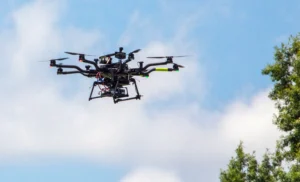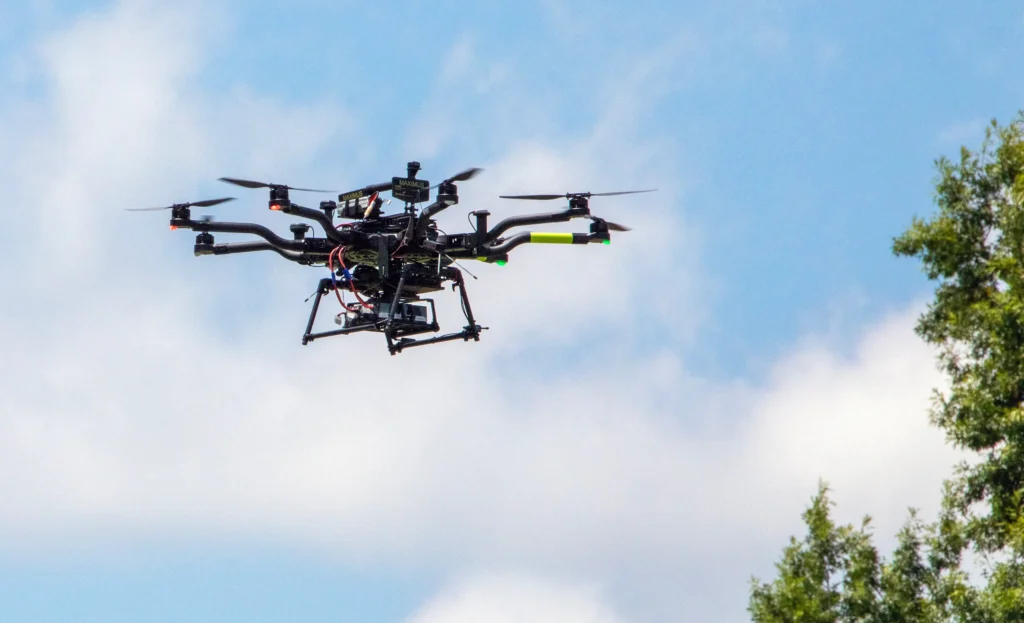
An Alta-8 small Unmanned Aircraft System testbed vehicle flies above NASA’s Langley Research Center in Hampton, Virginia. Flying beyond visual line of sight from observers on the ground required special approval from the FAA and NASA. NASA / Bowman
Advancements in Autonomous Drone Flight: Insights from NASA Researcher Jeffrey Homola
by DRONELIFE Contributing Editor Paul Rossi
At the AUVSI Xponential 2024, an event showcasing the latest innovations in unmanned systems, NASA’s recent achievement of flying multiple drones autonomously beyond visual line of sight marks a pivotal advancement in drone technology. I had the privilege to sit down with Jeffrey Homola, a NASA researcher, to discuss the details and implications of these groundbreaking tests.
Pioneering Technologies for Autonomous Flight
Homola began by explaining the sophisticated technologies and systems that enable the operation of multiple drones without a visual observer. “The core of this achievement is the High Density Vertiplex system, which began with pushing simulated aircraft data for initial tests,” he shared. This approach allowed the team to validate connections and systems incrementally before introducing drones flying in real-time.
“A critical component of the system is the integration of Provider Services for Urban Air Mobility (UAM) and Fleet Management Services,” Homola added. These services facilitate efficient operation management and coordination between multiple drones. The operational architecture is uniquely distributed with the Flight Manager located in California and Flight Operations centered at NASA’s Langley Research Center in Hampton, Virginia, highlighting a complex yet efficient nationwide operation.
Implications for Future Drone Operations
Discussing the broader implications of these tests, Homola emphasized their potential impact on both urban and rural drone operations. “These tests lay a foundation of safety that allows for scalability,” he stated. This foundational safety starts at the ground level, with rigorous testing and system validations that meet stringent standards.
Homola also pointed out the collaborative efforts between the FAA and the drone industry, facilitated by NASA, which are crucial for integrating these advanced operations into national airspace. “The ability to safely manage multiple drone operations in dense areas without visual line of sight is a significant step forward,” he remarked.
Overcoming Challenges
Addressing the challenges faced during the project, Homola highlighted the inherent difficulties in managing multiple unmanned aircraft systems (UAS) flying beyond visual line of sight (BVLOS). “The challenge we focused on was the complexity of autonomous BVLOS operations itself,” he explained. This involved ensuring robust communication and control systems that can reliably manage multiple drones simultaneously in diverse environments.
Homola emphasized the team’s dedication to safety and innovation to tackle these complexities. The approach was to advance the technology step-by-step, validating each layer of the system through rigorous testing and simulation. This methodical progression ensured that each phase of the operation met the highest standards of safety and functionality before moving on to more complex scenarios.
By focusing on these technical hurdles, NASA’s team was able to develop a sophisticated framework for autonomous drone operations, setting a new benchmark for safety and efficiency in aerial robotics.
A Message to DroneLife.com Readers
To the readers of DroneLife.com, Homola wishes to convey the significance of NASA’s ongoing role in pioneering aeronautic technologies. “NASA has historically played a key role in the evolution of aviation, and our current research is paving the way for the third revolution in aviation,” he proudly stated. Homola concluded by stressing the importance of ongoing research and collaboration to advance drone technology safely and effectively.
Read more:

 Paul Rossi is the Chief Operations Officer and Chief Pilot atNine Ten Drones, a N. C.-based drone services company, training center, and reseller. Rossi is also the Outreach Coordinator for the North Carolina Chapter of AUVSI. A graduate of Embry Riddle Aeronautical University and the U.S. Army Aviation Logistics School, Rossi is passionate about the aviation industry. He holds both a private pilot’s license for manned aircraft and a Part 107 Remote Pilot’s Certificate. You can see more videos and product information on the Nine Ten Drones YouTube channel.
Paul Rossi is the Chief Operations Officer and Chief Pilot atNine Ten Drones, a N. C.-based drone services company, training center, and reseller. Rossi is also the Outreach Coordinator for the North Carolina Chapter of AUVSI. A graduate of Embry Riddle Aeronautical University and the U.S. Army Aviation Logistics School, Rossi is passionate about the aviation industry. He holds both a private pilot’s license for manned aircraft and a Part 107 Remote Pilot’s Certificate. You can see more videos and product information on the Nine Ten Drones YouTube channel.
Miriam McNabb is the Editor-in-Chief of DRONELIFE and CEO of JobForDrones, a professional drone services marketplace, and a fascinated observer of the emerging drone industry and the regulatory environment for drones. Miriam has penned over 3,000 articles focused on the commercial drone space and is an international speaker and recognized figure in the industry. Miriam has a degree from the University of Chicago and over 20 years of experience in high tech sales and marketing for new technologies.
For drone industry consulting or writing, Email Miriam.
TWITTER:@spaldingbarker
Subscribe to DroneLife here.
